An official website of the United States government
 United States Department of Labor
United States Department of Labor
All protective service workers not listed separately.
Employment estimate and mean wage estimates for Protective Service Workers, All Other:
| Employment (1) | Employment RSE (3) |
Mean hourly wage |
Mean annual wage (2) |
Wage RSE (3) |
|---|---|---|---|---|
| 100,110 | 2.4 % | $ 20.27 | $ 42,160 | 0.7 % |
Percentile wage estimates for Protective Service Workers, All Other:
| Percentile | 10% | 25% | 50% (Median) |
75% | 90% |
|---|---|---|---|---|---|
| Hourly Wage | $ 13.80 | $ 15.00 | $ 18.37 | $ 22.96 | $ 29.57 |
| Annual Wage (2) | $ 28,690 | $ 31,190 | $ 38,210 | $ 47,760 | $ 61,510 |
Industries with the highest published employment and wages for Protective Service Workers, All Other are provided. For a list of all industries with employment in Protective Service Workers, All Other, see the Create Customized Tables function.
Industries with the highest levels of employment in Protective Service Workers, All Other:
| Industry | Employment (1) | Percent of industry employment | Hourly mean wage | Annual mean wage (2) |
|---|---|---|---|---|
| Elementary and Secondary Schools | 35,550 | 0.44 | $ 17.18 | $ 35,730 |
| Local Government, excluding schools and hospitals (OEWS Designation) | 15,130 | 0.28 | $ 21.97 | $ 45,700 |
| Investigation and Security Services | 10,010 | 1.09 | $ 23.62 | $ 49,130 |
| Warehousing and Storage | 6,370 | 0.38 | $ 22.32 | $ 46,430 |
| Federal Executive Branch (OEWS Designation) | 4,100 | 0.19 | $ 24.12 | $ 50,180 |
Industries with the highest concentration of employment in Protective Service Workers, All Other:
| Industry | Employment (1) | Percent of industry employment | Hourly mean wage | Annual mean wage (2) |
|---|---|---|---|---|
| Investigation and Security Services | 10,010 | 1.09 | $ 23.62 | $ 49,130 |
| School and Employee Bus Transportation | 1,570 | 0.88 | $ 15.50 | $ 32,230 |
| Other Transit and Ground Passenger Transportation | 440 | 0.52 | $ 14.58 | $ 30,330 |
| Elementary and Secondary Schools | 35,550 | 0.44 | $ 17.18 | $ 35,730 |
| Warehousing and Storage | 6,370 | 0.38 | $ 22.32 | $ 46,430 |
Top paying industries for Protective Service Workers, All Other:
| Industry | Employment (1) | Percent of industry employment | Hourly mean wage | Annual mean wage (2) |
|---|---|---|---|---|
| Aerospace Product and Parts Manufacturing | 240 | 0.05 | $ 46.84 | $ 97,440 |
| Architectural, Engineering, and Related Services | 140 | 0.01 | $ 44.43 | $ 92,410 |
| Electric Power Generation, Transmission and Distribution | 70 | 0.02 | $ 40.55 | $ 84,340 |
| Postal Service (federal government) | 250 | 0.04 | $ 39.08 | $ 81,290 |
| Other Professional, Scientific, and Technical Services | (8) | (8) | $ 36.52 | $ 75,960 |
States and areas with the highest published employment, location quotients, and wages for Protective Service Workers, All Other are provided. For a list of all areas with employment in Protective Service Workers, All Other, see the Create Customized Tables function.
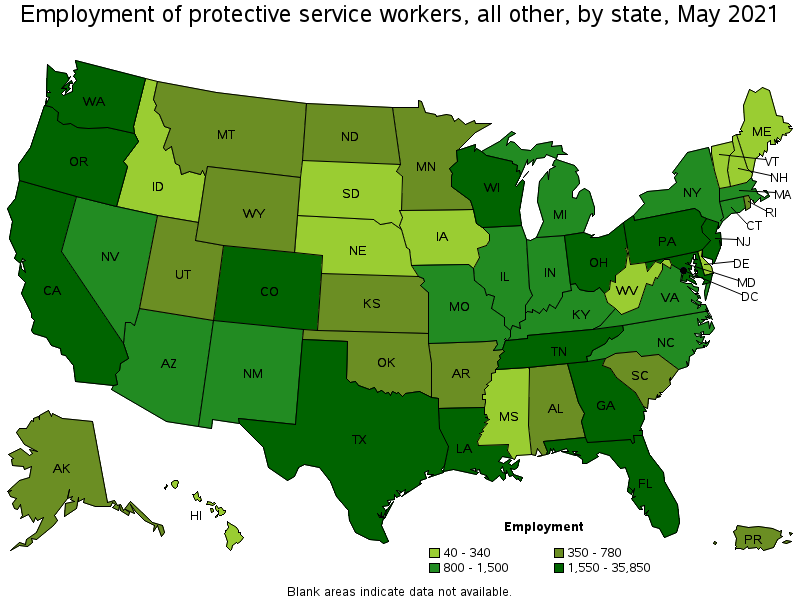
States with the highest employment level in Protective Service Workers, All Other:
| State | Employment (1) | Employment per thousand jobs | Location quotient (9) | Hourly mean wage | Annual mean wage (2) |
|---|---|---|---|---|---|
| California | 35,850 | 2.17 | 3.05 | $ 20.13 | $ 41,870 |
| Pennsylvania | 5,290 | 0.95 | 1.33 | $ 16.26 | $ 33,810 |
| Florida | 5,240 | 0.61 | 0.86 | $ 18.35 | $ 38,170 |
| New Jersey | 4,610 | 1.20 | 1.68 | $ 20.35 | $ 42,340 |
| Texas | 3,940 | 0.32 | 0.45 | $ 19.66 | $ 40,880 |
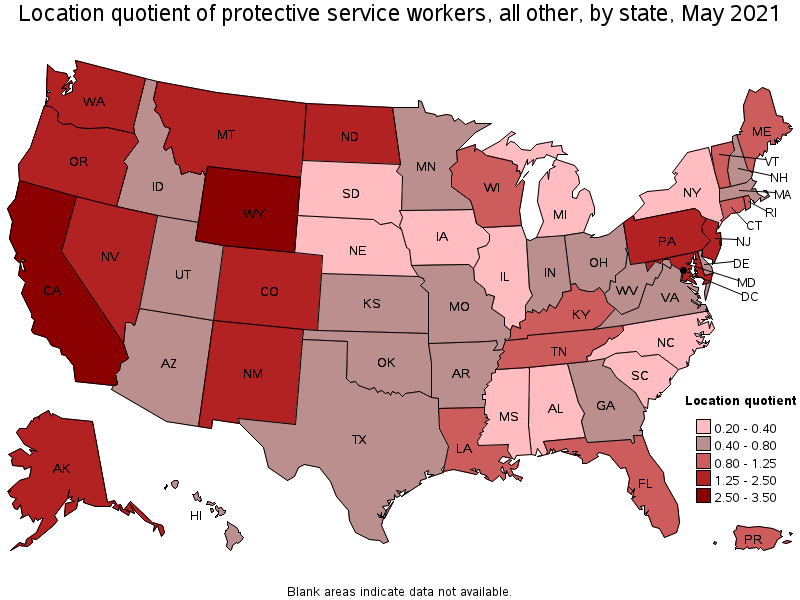
States with the highest concentration of jobs and location quotients in Protective Service Workers, All Other:
| State | Employment (1) | Employment per thousand jobs | Location quotient (9) | Hourly mean wage | Annual mean wage (2) |
|---|---|---|---|---|---|
| California | 35,850 | 2.17 | 3.05 | $ 20.13 | $ 41,870 |
| Wyoming | 540 | 2.09 | 2.94 | $ 20.86 | $ 43,380 |
| Colorado | 3,650 | 1.39 | 1.96 | $ 19.83 | $ 41,240 |
| Alaska | 410 | 1.37 | 1.93 | $ 23.87 | $ 49,640 |
| New Jersey | 4,610 | 1.20 | 1.68 | $ 20.35 | $ 42,340 |
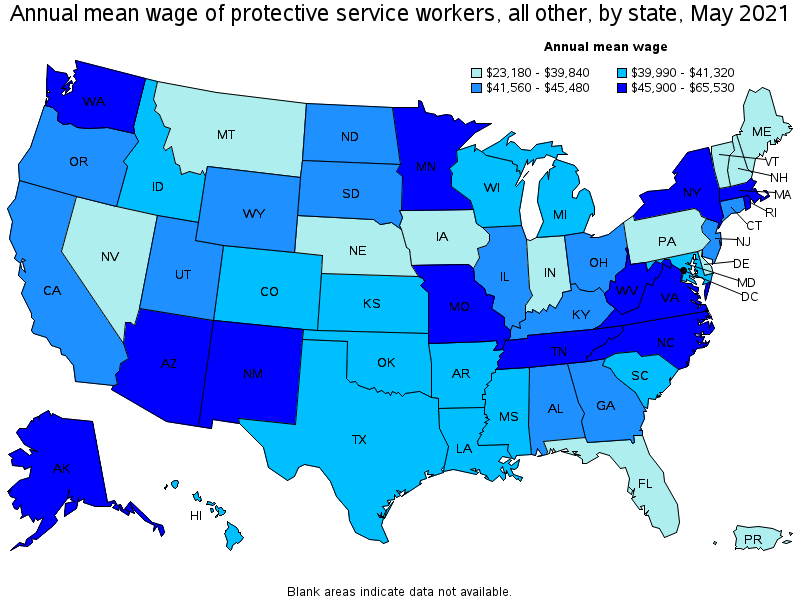
Top paying states for Protective Service Workers, All Other:
| State | Employment (1) | Employment per thousand jobs | Location quotient (9) | Hourly mean wage | Annual mean wage (2) |
|---|---|---|---|---|---|
| District of Columbia | 170 | 0.26 | 0.36 | $ 31.50 | $ 65,530 |
| New Mexico | 800 | 1.04 | 1.46 | $ 28.19 | $ 58,630 |
| West Virginia | 230 | 0.34 | 0.48 | $ 24.20 | $ 50,330 |
| Alaska | 410 | 1.37 | 1.93 | $ 23.87 | $ 49,640 |
| Tennessee | 2,000 | 0.67 | 0.94 | $ 23.71 | $ 49,320 |
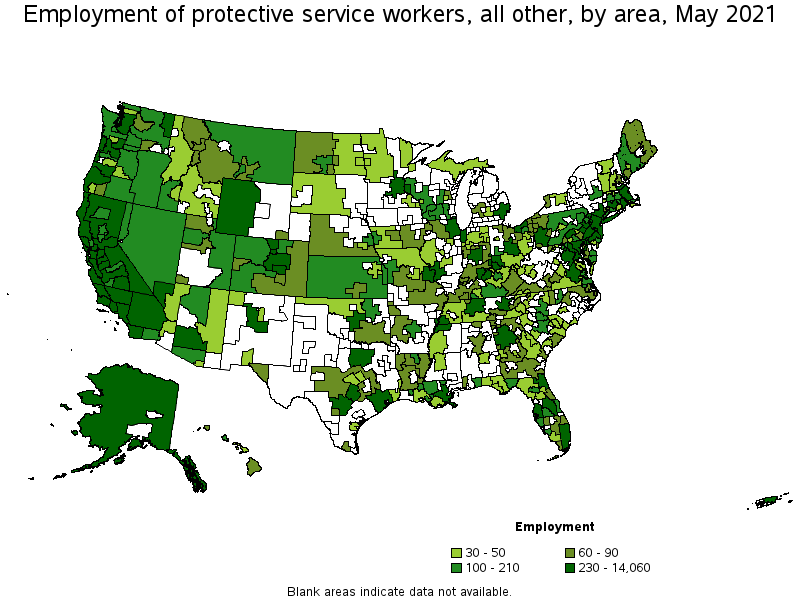
Metropolitan areas with the highest employment level in Protective Service Workers, All Other:
| Metropolitan area | Employment (1) | Employment per thousand jobs | Location quotient (9) | Hourly mean wage | Annual mean wage (2) |
|---|---|---|---|---|---|
| Los Angeles-Long Beach-Anaheim, CA | 14,060 | 2.46 | 3.46 | $ 19.77 | $ 41,120 |
| Riverside-San Bernardino-Ontario, CA | 4,330 | 2.83 | 3.98 | $ 19.84 | $ 41,270 |
| New York-Newark-Jersey City, NY-NJ-PA | 4,080 | 0.47 | 0.66 | $ 21.84 | $ 45,440 |
| Philadelphia-Camden-Wilmington, PA-NJ-DE-MD | 3,260 | 1.23 | 1.73 | $ 15.39 | $ 32,010 |
| San Francisco-Oakland-Hayward, CA | 3,040 | 1.36 | 1.91 | $ 26.28 | $ 54,670 |
| San Diego-Carlsbad, CA | 2,340 | 1.68 | 2.37 | $ 19.84 | $ 41,270 |
| Seattle-Tacoma-Bellevue, WA | 1,940 | 1.01 | 1.43 | $ 23.84 | $ 49,590 |
| Washington-Arlington-Alexandria, DC-VA-MD-WV | 1,840 | 0.63 | 0.88 | $ 22.83 | $ 47,480 |
| Denver-Aurora-Lakewood, CO | 1,810 | 1.23 | 1.73 | $ 20.36 | $ 42,340 |
| Sacramento--Roseville--Arden-Arcade, CA | 1,770 | 1.80 | 2.53 | $ 20.52 | $ 42,670 |
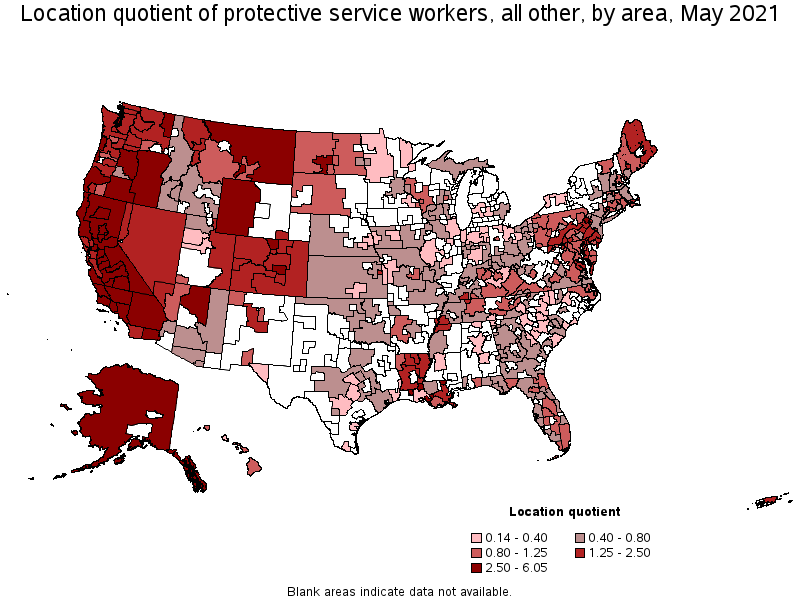
Metropolitan areas with the highest concentration of jobs and location quotients in Protective Service Workers, All Other:
| Metropolitan area | Employment (1) | Employment per thousand jobs | Location quotient (9) | Hourly mean wage | Annual mean wage (2) |
|---|---|---|---|---|---|
| Yuba City, CA | 200 | 4.30 | 6.05 | $ 16.52 | $ 34,370 |
| Merced, CA | 270 | 3.69 | 5.20 | $ 16.23 | $ 33,750 |
| El Centro, CA | 210 | 3.62 | 5.09 | $ 16.74 | $ 34,810 |
| Madera, CA | 170 | 3.57 | 5.02 | $ 16.25 | $ 33,810 |
| Salinas, CA | 570 | 3.37 | 4.75 | $ 17.74 | $ 36,910 |
| Visalia-Porterville, CA | 490 | 3.26 | 4.59 | $ 18.16 | $ 37,770 |
| Stockton-Lodi, CA | 800 | 3.14 | 4.41 | $ 16.70 | $ 34,740 |
| Hanford-Corcoran, CA | 130 | 2.94 | 4.13 | $ 16.96 | $ 35,270 |
| Modesto, CA | 530 | 2.92 | 4.11 | $ 17.31 | $ 36,000 |
| Oxnard-Thousand Oaks-Ventura, CA | 850 | 2.86 | 4.02 | $ 17.23 | $ 35,830 |
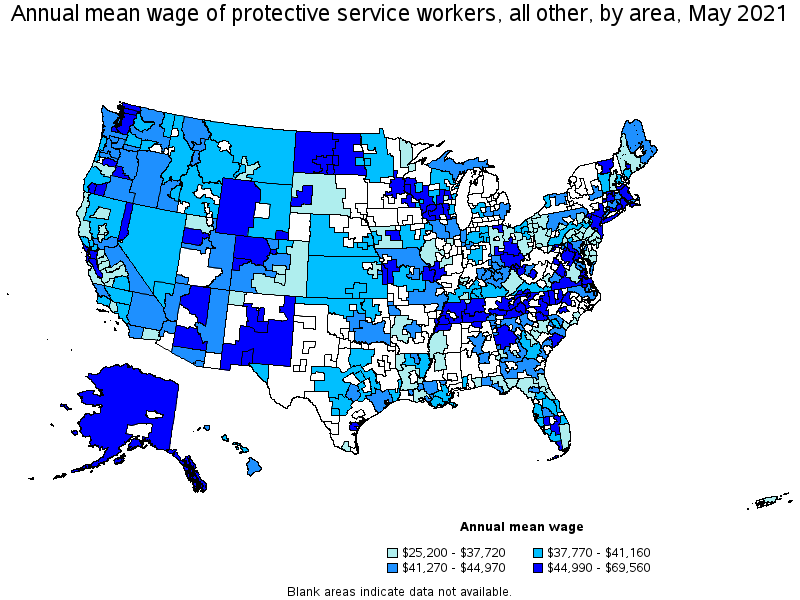
Top paying metropolitan areas for Protective Service Workers, All Other:
| Metropolitan area | Employment (1) | Employment per thousand jobs | Location quotient (9) | Hourly mean wage | Annual mean wage (2) |
|---|---|---|---|---|---|
| Raleigh, NC | 90 | 0.14 | 0.20 | $ 33.44 | $ 69,560 |
| Albuquerque, NM | 370 | 1.00 | 1.41 | $ 30.81 | $ 64,090 |
| Columbus, OH | 380 | 0.37 | 0.52 | $ 28.34 | $ 58,950 |
| Huntsville, AL | 60 | 0.24 | 0.34 | $ 27.70 | $ 57,620 |
| Durham-Chapel Hill, NC | 150 | 0.47 | 0.66 | $ 26.80 | $ 55,750 |
| Rochester, MN | 30 | 0.26 | 0.37 | $ 26.74 | $ 55,620 |
| San Francisco-Oakland-Hayward, CA | 3,040 | 1.36 | 1.91 | $ 26.28 | $ 54,670 |
| Cumberland, MD-WV | 30 | 0.88 | 1.24 | $ 25.36 | $ 52,740 |
| San Jose-Sunnyvale-Santa Clara, CA | 1,490 | 1.39 | 1.96 | $ 25.07 | $ 52,150 |
| Nashville-Davidson--Murfreesboro--Franklin, TN | 640 | 0.65 | 0.92 | $ 24.78 | $ 51,550 |
Nonmetropolitan areas with the highest employment in Protective Service Workers, All Other:
| Nonmetropolitan area | Employment (1) | Employment per thousand jobs | Location quotient (9) | Hourly mean wage | Annual mean wage (2) |
|---|---|---|---|---|---|
| Alaska nonmetropolitan area | 300 | 3.06 | 4.30 | $ 25.27 | $ 52,560 |
| Western Wyoming nonmetropolitan area | 260 | 2.80 | 3.94 | $ 21.98 | $ 45,710 |
| North Coast Region of California nonmetropolitan area | 260 | 2.58 | 3.62 | $ 17.93 | $ 37,300 |
| Coast Oregon nonmetropolitan area | 250 | 2.31 | 3.25 | $ 19.66 | $ 40,890 |
| North Valley-Northern Mountains Region of California nonmetropolitan area | 240 | 2.50 | 3.52 | $ 19.29 | $ 40,110 |
Nonmetropolitan areas with the highest concentration of jobs and location quotients in Protective Service Workers, All Other:
| Nonmetropolitan area | Employment (1) | Employment per thousand jobs | Location quotient (9) | Hourly mean wage | Annual mean wage (2) |
|---|---|---|---|---|---|
| Eastern Sierra-Mother Lode Region of California nonmetropolitan area | 240 | 4.24 | 5.96 | $ 20.32 | $ 42,260 |
| Alaska nonmetropolitan area | 300 | 3.06 | 4.30 | $ 25.27 | $ 52,560 |
| Western Wyoming nonmetropolitan area | 260 | 2.80 | 3.94 | $ 21.98 | $ 45,710 |
| North Coast Region of California nonmetropolitan area | 260 | 2.58 | 3.62 | $ 17.93 | $ 37,300 |
| Southwest Louisiana nonmetropolitan area | 170 | 2.56 | 3.60 | $ 21.23 | $ 44,160 |
Top paying nonmetropolitan areas for Protective Service Workers, All Other:
| Nonmetropolitan area | Employment (1) | Employment per thousand jobs | Location quotient (9) | Hourly mean wage | Annual mean wage (2) |
|---|---|---|---|---|---|
| Eastern New Mexico nonmetropolitan area | (8) | (8) | (8) | $ 25.89 | $ 53,860 |
| Alaska nonmetropolitan area | 300 | 3.06 | 4.30 | $ 25.27 | $ 52,560 |
| South Central Wisconsin nonmetropolitan area | 100 | 0.50 | 0.70 | $ 24.35 | $ 50,650 |
| East Tennessee nonmetropolitan area | 90 | 0.69 | 0.98 | $ 23.69 | $ 49,270 |
| Southside Virginia nonmetropolitan area | 50 | 0.55 | 0.78 | $ 23.19 | $ 48,230 |
These estimates are calculated with data collected from employers in all industry sectors, all metropolitan and nonmetropolitan areas, and all states and the District of Columbia. The top employment and wage figures are provided above. The complete list is available in the downloadable XLS files.
The percentile wage estimate is the value of a wage below which a certain percent of workers fall. The median wage is the 50th percentile wage estimate—50 percent of workers earn less than the median and 50 percent of workers earn more than the median. More about percentile wages.
(1) Estimates for detailed occupations do not sum to the totals because the totals include occupations not shown separately. Estimates do not include self-employed workers.
(2) Annual wages have been calculated by multiplying the hourly mean wage by a "year-round, full-time" hours figure of 2,080 hours; for those occupations where there is not an hourly wage published, the annual wage has been directly calculated from the reported survey data.
(3) The relative standard error (RSE) is a measure of the reliability of a survey statistic. The smaller the relative standard error, the more precise the estimate.
(8) Estimate not released.
(9) The location quotient is the ratio of the area concentration of occupational employment to the national average concentration. A location quotient greater than one indicates the occupation has a higher share of employment than average, and a location quotient less than one indicates the occupation is less prevalent in the area than average.
Other OEWS estimates and related information:
May 2021 National Occupational Employment and Wage Estimates
May 2021 State Occupational Employment and Wage Estimates
May 2021 Metropolitan and Nonmetropolitan Area Occupational Employment and Wage Estimates
May 2021 National Industry-Specific Occupational Employment and Wage Estimates
Last Modified Date: March 31, 2022